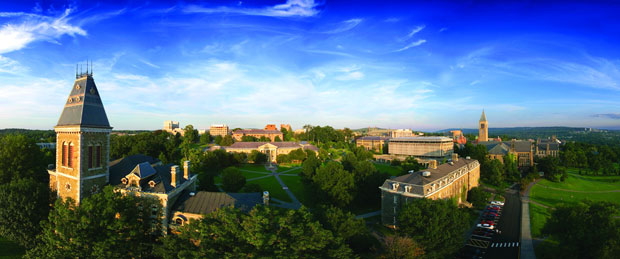
On April 27, 1865, Governor Reuben E. Fenton signed the bill into law, and Cornell University came into existence. We might rightfully ask: What happened next? How did this all pan out? What was made of this unique opportunity? The answers are "a lot," "fine," and "take a look at us now."
Over time, the lone professor of agriculture became a department and then a school; the subject broadened to include domestic science and even hotel management. Agriculture also meant the care and physiology of plants and animals, entomology, geology, veterinary medicine and surgery, zoology and microscopical technology, histology and embryology. It provided another reason for the teaching of physics and chemistry, physiology, anatomy and geology, botany, horticulture and arboriculture, not to mention the need for mathematics and languages. The mechanical arts took just as many forms: civil and electrical engineering, practical mechanics, mechanical engineering, applied mathematics, experimental engineering, and marine engineering. There was, of course, the study of military science and tactics. But there was also room for instruction in political science, law, history, and English—all during the University's first thirty years.
Today all of this can be found at Cornell University. The names of some of the subjects have changed, older fields have evolved, and new ones have been introduced. But there seems to be a way to find a fit for almost everything.
While agriculture and engineering education have expanded beyond all expectations, only the presence of military science on campus has been challenged. Along with the Sixties student protests against the Vietnam War, anti-ROTC protests rumbled across the University, continuing until 1974. The University rode out the storm, and ROTC remains—less popular than it once was, but a means of financial support and career advancement for others. The requirements of the Morrill Land Grant Act remain in place.
The Morrill Act ultimately propelled American education onto a new and more democratic path—expanding subject matter and redefining who might be a student. In this, the federal government responded to its own interests and to the people's needs by acting with both resolve and money. Following the Morrill Act came many other significant federal programs to enhance and expand higher education. The Hatch Act (1887) established agricultural experiment stations, and the second Morrill Land Grant Act (1890) further endowed land-grant colleges and set up institutions throughout the South for African Americans denied entry elsewhere. The Nelson Act (1907) expanded funding for land-grant institutions. The two Smith-Lever Acts (1914 and 1953) expanded offerings at land-grant universities. The Fulbright program began in 1946, and the National Science Foundation was launched in 1950.
It is impossible to think of higher education in this country without these and subsequent pieces of federal legislation, all of which owe a debt to the Morrill Act. American universities educate individuals, promote a culture of learning, and facilitate the exchange of ideas; we would be a lesser nation without this partnership. As for Cornell University, it has been said that it is "the jewel of the land-grant colleges."
Carol Kammen, the Tompkins County historian, taught Cornell students about the history of their university for more than twenty years and is the author of Cornell: Glorious to View and First-Person Cornell.
Author's note: With much appreciation for the aid of Elaine Engst, MA '72, university archivist, and Richard Polenberg, emeritus professor of history. I am glad, also, to acknowledge the work of two others: Carl Becker and Morris Bishop.


